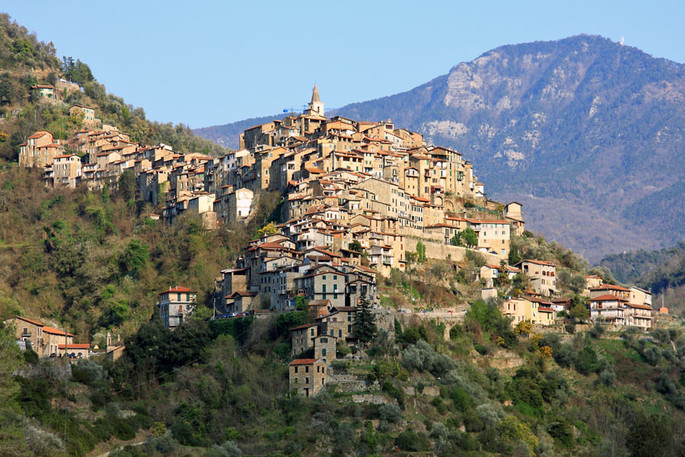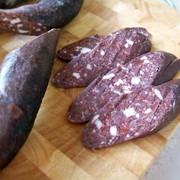Geography
The medieval village is located in the hinterland of Bordighera, in the valley of Merdanzo, a tributary of the Nervia, 13 km from the coast of the Riviera di Ponente. In the background is visible Mount Bignone (1,299 meters). It is approximately 52 km from the capital.
History
The origin of the village seems to date to the Bronze Age, thanks to the findings of sepulchral tumoli at Pian del Re (in the local dialect Cian deu Re). Officially, the village was founded around the tenth century by Counts from Ventimiglia, then passed in 1276 to the Doria, the lords of Dolceacqua.
In 1267 appeared the first statutes, among the oldest in Liguria, related to independence for storage in a free city. In 1573 the Grimaldi family of Monaco destroyed the local castle, previously built by the Doria, triggering fights and internal wars.
Apricale was invaded by the French in 1794 with Napoleon Bonaparte and the subsequent annexation of the Ligurian Republic (1797) and then during the First French Empire in 1805. After the fall of the latter, in 1815, was incorporated in the Kingdom of Sardinia, as established by the Congress of Vienna, and later in the Kingdom of Italy from 1861.
From 1973 to April 30, 2011 has been part of the mountain community Intemelia latter suppressed by the Regional Law n ° 23 of 29 December 2010 and in force since 1 May 2011.
Statutes for the community
Important for Apricale were the medieval historic municipal statutes of 1267, considered the oldest in Liguria, which regularized the life of the inhabitants of the village with very specific rules and foundations. Every aspect is carefully contemplated, ranging from the regularization of the main livelihood activities, the payment of taxes and duties and of course the choices of conviction for toughest crimes.
Precisely on the issue of justice are applied several times terrible punitive regulations, the burial of the killer (still alive) with the victim, the beheading of adulterous women or the amputation of a foot or hand for rustlers. The theft had to be prevented by the two field guards - forced to sleep every day in summer and two nights in the winter during the night hours in the fields - and obligated themselves to material compensation as a result of the failure to arrest the alleged thieves after eight days of theft .
The statutes also resorted to the "judgment of God" always on justice: the prosecuted because of damage or theft to third parties could be found innocent if he could walk - for a short distance - with a hot iron in his hand without burning.
Symbols
The presence of a sailing ship in the municipal coat of arms, rather curious for a medieval village perched in the inland, lies in the historical collaboration between the country and the shipyards on the coast; in fact the wood for the construction of ships for the maritime fleet of the Republic of Genoa, came from the forests of Apricale's timbers.
Monuments and places of interest
Religious Architecture
. Parish Church of the Purification of the Virgin Mary.
The church, built around the twelfth century, was remodeled several times and enlarged. In 1760 a restoration transformed the Baroque-style building. The neo-Romanesque façade was rebuilt in 1935. The church tower was obtained from the ancient square tower of the castle of the Lizard in the top of which was attached a bicycle facing up. The strange and curious installation is nothing but a work of contemporary art in 2000 by Sergio Bianco: The force of not gravity.
. Church of Santa Maria degli Angeli.
Located at the foot of the country, home to frescoes dating from the fifteenth century.
. Church of St. Anthony.
Dating back to the XIII century it was built near the local cemetery on the ruins of an ancient Romanesque temple.
. Oratorio di San Bartolomeo.
Keeps inside a wooden polyptych from 1544.
. Ruins of the church of San Pietro in Ento.
The first parish of the area dating back to the eleventh or twelfth century.
. Chapel of St. Vincent Ferrer.
Dating back to the sixteenth century, but reworked in Baroque style, is located along the road to Perinaldo about a kilometer from the center of Apricale. Keeps in a niche of the façade the statue of the saint.
. Chapel of St. Martin.
Perhaps already ancient Roman church, the first informations about the chapel date back to the sixteenth century. It retains traces of frescoes in the apse.
. Chapel of San Rocco.
Built on the trail for Pigna, in the northern part of the village of Apricale, it is mentioned in a will of 1576.
. Chapel of Moudena.
Located on the trail to the region Moudena.
Military architecture
Castello della Lucertola (Castle of the Lizard).
Built on a rock by the Counts of Ventimiglia in the tenth century, it faces dominating the main square of Apricale as well as the adjacent church of the Purification of the Virgin Mary. The ownership of the castle - as well as the domination of the village - passed from the Genovese family Doria (experiencing in 1523 the siege of the bishop Agostino Grimaldi for his brother's death) to the Savoy and finally to the local family Cassini who transformed the building from a defensive position to a private residence. Become property of the City of Apricale, after careful restoration, it is home to annual and cultural events.
In the center of town, down a narrow medieval street, houses the town library, while in the interior of the castle is the Museum of history of Apricale which preserves historical artifacts and documents, such as the famous Statuti apricalesi from 1267.
Events
are organized every year: photo, sculptures and paintings exhibitions,in the castle of the Lizard. The front of the square, the heart of the Apricale village, is the scene of several local events such as the "feast of the new oil", the "spring festival", the feast of St. Valentine's Day in February and the "festival of pansarola" ( sweet pancakes) on the second Sunday of September.
Persons linked to Apricale
. Cristina Anna Bellomo (1861-1904), Countess of Apricale.
Her life and tragic romance is evoked in the castle of the Lizard. Abandoned after the wedding by Baptist Pisano, she served Count Charles de La Tour who fell in love with her and took her to Paris, introducing her to worldly living and leaving her, at his death, a fortune. Beautiful and very courted, traveled to Russia with her niece Maria Pizzio at the court of the Tsar, here she met Sergei Alexandrovich Romanov, the Tsar's brother, who fell in love. Sent to the Far East by the Russian government as spies, Maria and Cristina were discovered and imprisoned. Maria, died of tuberculosis, while Cristina was able to return to Apricale with the intention to divorce from her husband in order to marry the Grand Duke. Pisano, seized with a fit of jealousy, killed her before committing suicide by hanging himself at the cross of the cemetery of Bajardo.
. Emanuele Luzzati (Genoa 1921 - Genoa, 2007), set designer, animator and illustrator, 14 September 2003 he was awarded an honorary citizenship.
Until recently was supported the hypothesis of the apricalese origin of Giovanni Martini, known to be the only survivor of the Custer column at the Battle of Little Bighorn, initiating a kind of dispute about the birth with the town of Sala Consilina (Salerno region). The dispute was finally resolved September 18, 2010 when the new official survey, in particular the discovery of the birth certificate, identified the famous bugler John Martin in the figure of John Chrysostom Martino, who was born in the Salese city January 28, 1852.
Economy
It is mainly based on agriculture and tourism. This village produces a high-quality olive oil, of the taggiasca source, viticulture and Rossese wine grapes.
Transport
Apricale is situated along the provincial road 64 which connects Vallecrosia with Castel Vittorio.


























